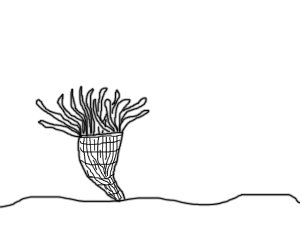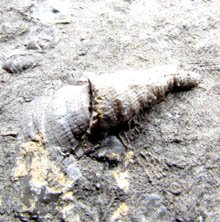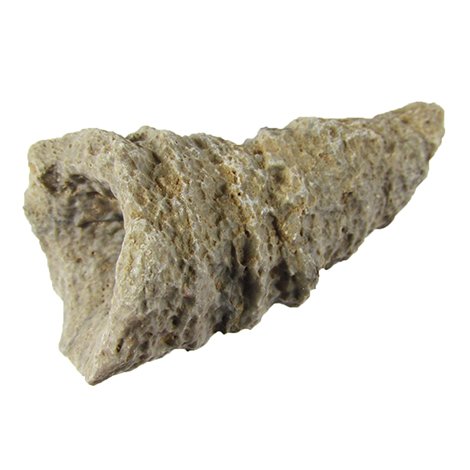Sign up for Lesson Plans, discounts & more!
Horn Corals
Reef Builders of the Paleozoic Era

Horn Corals are from the extinct order of corals called Rugosa. Rugose means wrinkled. The outside of these corals have a wrinkled appearance. Horn Coral grows in a long cone shapes like a bull’s horn. The fossil is the skeleton of the coral animal or polyp. They built these cone shaped structures from calcium carbonate that came from the ocean water. The animal lived at the top of the cone. As the animal got bigger it added more material to the cone. Each layer was a little bigger than the previous one. They had many tentacles sticking out to gather their food, plankton, from the seawater moving past them.. The tentacles gave them a flower like appearance.

Horn Coral Fossil Classification
All corals belong to the phylum of animals called Cnidaria. They are related to jellyfish. Horn coral classification looks like this:
Phylum- Cnidaria
Class- Anthrozoa
Sub class- Hexacorallia
Order- Rugosa
Horn Coral Structure
The internal structure of horn corals consisted of horizontal plates called tabulae and vertical walls called septa. The arrangement of these inner divisions are different for each species and are what is used to identify individual species.
There is also a central axial rod called the columella to help support the septa.
When Did Horn Corals Live?
The oldest of the Rugosa corals are found in rocks from the Ordovician Period. Many species evolved during the Paleozoic Era. During this time horn corals were so plentiful they helped to create reefs on the ocean floor.
As a group they flourished until the Permian Period when they became extinct along with most living things during the Great Permian Extinction.
Horn Coral Facts
While modern corals are colonial the now extinct horn corals could be colonial or solitary animals.
Horn Corals were carnivores but because the size of their prey is so small they are referred to as microcarnivors.
Horn corals are used by paleontologists as index fossils, to help determine the age of rock strata.
Fossil Horn Coral For Sale
Check out some of the Educational Materials for sale on our sister site fossilicious.com.

interested in more? If so, you may want to check out our other sites:
fossilicious.com - Our online fossil and mineral rock shop.
rocksandminerals4u.com - An educational site about rocks, minerals, and geology.
Geologic Time Geologic Time Line
Cenozoic Era
Quaternary
Neogene
Paleogene
Mesozoic Era
Cretaceous
Jurassic
Triassic
Paleozoic Era
Permian
Carboniferous
Devonian
Silurian
Ordovician
Cambrian
Archean Time
Hadean Time
Teachers Resources
Activities for Education and Fun
Earth Science Lesson Plans
Activities For Kids
Fossil Lesson Plans
Fossil Activities
Education Articles
Coloring Pages
Dinosaur Coloring Pages
Montessori Materials
Geology Club
Fossil Hunting
 |
 |
 |





